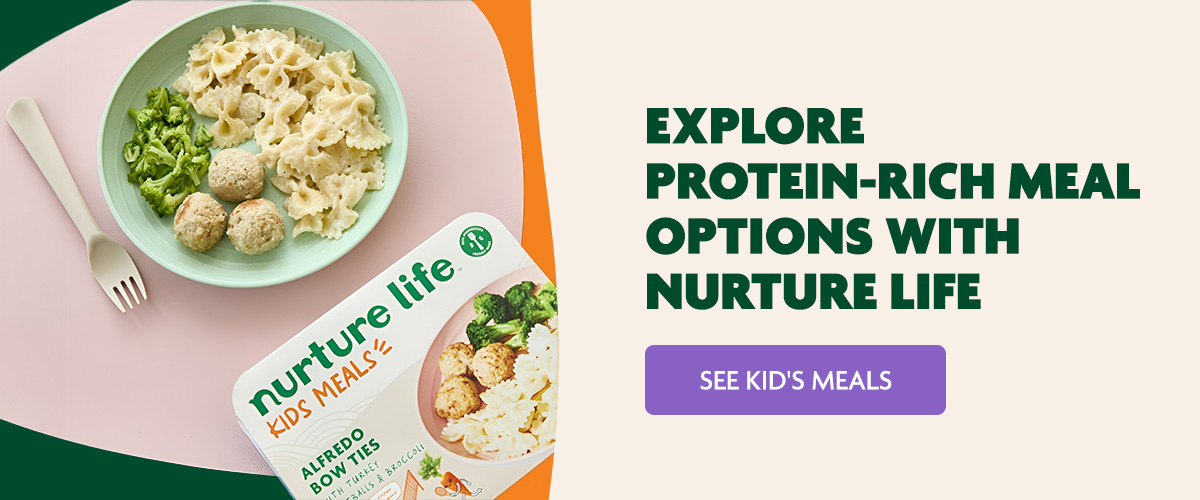Protein for Kids
- Why Is Protein Important for Kids?
- How Much Protein Should Kids Eat?
- Can Kids Eat Too Much Protein?
- What Are the Best Sources of Protein for Kids?
- Protein Requirements for Different Age Groups
- Are There Any Proteins to Avoid?
Powders, ice cream, cereals, snack bars, and even gummy bears—new high-protein sources are everywhere! But what exactly is a healthy amount of protein for kids? And which sources are best?
Just like a car needs fuel to run, your child’s body needs protein to keep going. It is an important nutrient for their growth. In this article, we explore foods that offer good protein for kids, ensuring they have the healthy and balanced diet they need to thrive.
Why Is Protein Important for Kids?
Protein is especially important for infants and children who are still growing and developing rapidly. Protein is considered a fundamental component in muscle building, maintenance, and repair. It also serves as an essential macronutrient, a category that includes carbohydrates and fats.
In the body, protein breaks down into amino acids, which in turn function as enzymes, hormones, and nutrient transporters to keep essential bodily functions running properly. Beyond our physical needs, protein also plays a role in satiation, helping us feel satisfied after a meal and cueing us to stop eating when we’re full.
How Much Protein Should Kids Eat?
On average, toddlers (ages 1-3) typically need about 13 grams (gm) of protein, while children ages 4-8 should have around 19 gm of protein daily. Kids ages 9-13 often need about 34 gm.
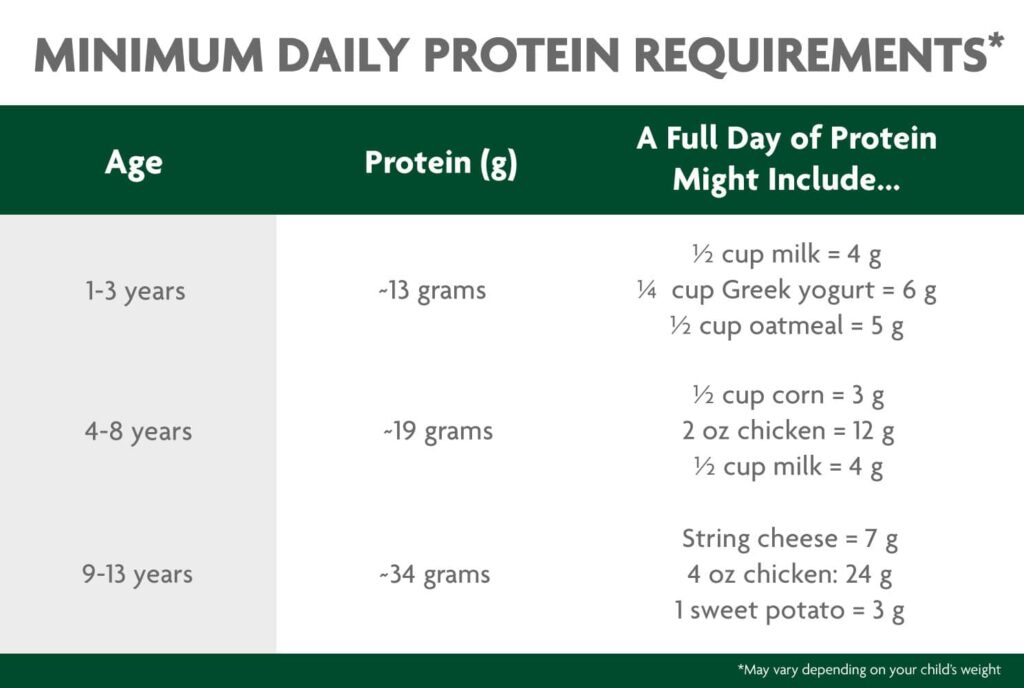
But how do grams of protein translate to real portions of food? Here are some examples of what children’s minimum daily protein requirements might look like at different ages:
- Ages 1-3: ½ cup of milk (4 gm), ¼ cup of Greek yogurt (6 gm), and ½ cup of oats (5 gm)
- Ages 4-8: ½ cup of corn (3 gm), 2 ounces of chicken (12 gm), and ½ cup of milk (4 gm)
- Ages 9-13: String cheese (7 gm), 4 ounces of chicken (24 gm), and 1 sweet potato (3 gm)
At Nurture Life, we aim for a minimum of six grams of protein per Finger Food meal and a minimum of eight grams of protein in each Kids Meal.
Can Kids Eat Too Much Protein?
While it is possible for kids to eat too much protein most health professionals agree that moderate protein intake is best, and the average individual should consume under 2 gm of protein per kilogram of body weight. The best thing to remember is to simply offer one serving of animal or plant-based protein per meal and snack.
Unless directed by a medical professional, you should not add protein supplements to your child’s meals or beverages. Excessive protein intake can harm your child’s kidneys and overall health. Keep it simple by offering a balance of food groups during meal and snack time.
What Are the Best Sources of Protein for Kids?
There are so many great protein sources out there, and a good rule of thumb is to vary the type of protein you’re serving. Provide a mix of vitamins and minerals to help your child become more familiar with new flavors, colors, and textures of foods. A week of healthy meals for kids can include a wide variety of protein sources. The chart below highlights some of our favorite lean animal proteins for kids, along with Nurture Life meals that offer these proteins:
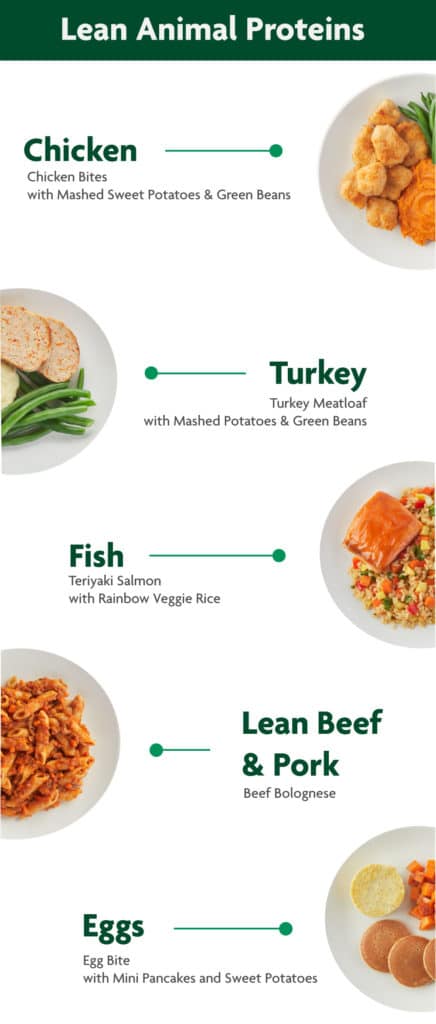
Protein Requirements for Different Age Groups
As kids grow, their bodies need different amounts of protein to stay healthy. The right intake largely depends on their development rate. Young children need protein to help them become stronger, while older kids need more protein to keep up with their growth. Consuming the right amount of protein for their age helps ensure kids are getting what their bodies need at every stage.
Toddlers (Ages 1-3)
Toddlers are growing quickly and need protein to support this physical development. Include small portions of protein-rich foods like dairy, beans, and eggs throughout the day.
School-Age Children (Ages 4-8)
Your school-age children need to increase their protein intake to support steady growth. Give them a balanced diet with protein from options like fish, chicken, or plant-based sources. At this age, it’s important to ensure they eat a variety of foods.
Pre-Teens (Ages 9-12)
Pre-teens are growing fast as they approach puberty, so they need another protein increase. Ensure their meals have a good mix of different protein sources like eggs, legumes, and lean meats.
Adolescents (Ages 13-18)
The teenagers’ growth spurt demands even more protein. If your child is very active or plays sports, focus their meals on protein-rich sources to support this increased muscle use. Give them foods like tofu, nuts, lean meats, and dairy.
Creative Ways to Incorporate Protein Into Kids’ Diets
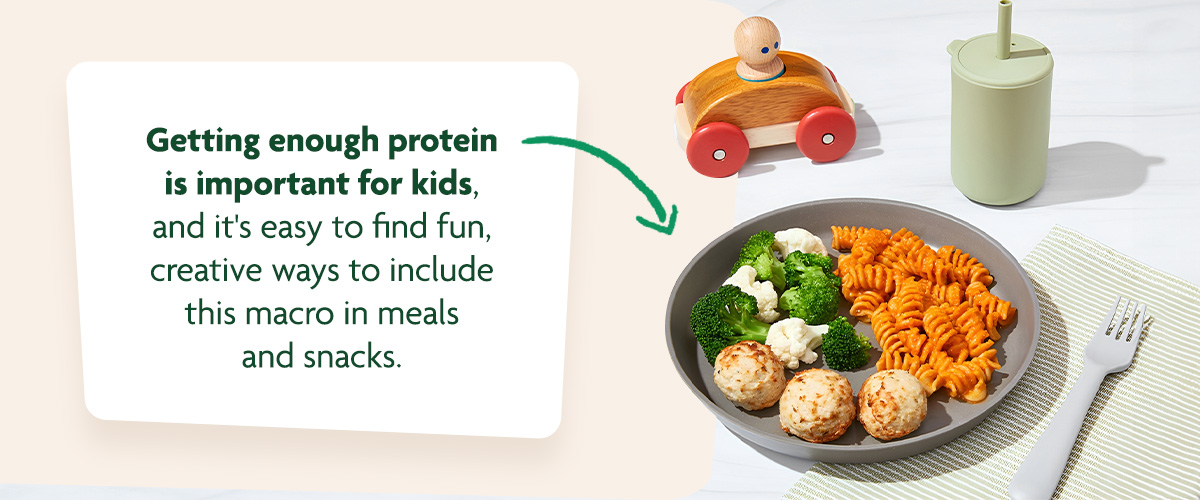
Getting enough protein is important for kids, plus it’s easy to find fun and creative ways to include this macronutrient in meals and snacks. There are many delicious options to explore!
Protein-Rich Snack Ideas
Keep your kids energized between meals with protein-rich snacks. From easy grab-and-go options to simple favorites, these snacks pack a protein punch:
- Mighty Bites: Enjoy protein-packed snacks with Mighty Bites, made with clean ingredients and less added sugar than your average kids’ snack bar. From snickerdoodle to oatmeal raisin and chocolate chip bites, our menu has various flavor options available.
- Super Sammies: Made with 58% less added sugar than the leading crustless sandwich brand, Super Sammies are crustless sandwiches made with sunflower seed butter and real fruit fillings.
Fun Protein-Packed Recipes for Kids
With some creativity and our help, you can whip up tasty protein-packed meals for your kids in a flash. For a breakfast that will keep your kids fuller for longer, try Southwestern Egg Cups. You could also try our Oaties, a fresh take on delicious overnight oats available in four flavors:
- Very Strawberry
- Apple Cinnamon
- Blueberry Bliss
- Banana Bread
Try a hummus and veggies snack or meal for a healthy mix of fiber and protein. You can also opt for more filling protein-filled dinners like meatloaf, tortilla chicken bean soup or pork souvlaki with lemon rice.
Are There Any Proteins to Avoid?
In general, it’s best not to completely restrict a type of food because strict boundaries tend to increase its appeal, making our kids long for the forbidden fruit, or, in this case, fast-food chicken tenders or overly processed meat products. To help encourage a positive relationship with food, it’s best to show our kids that all foods can be enjoyed and shared in moderation.
That being said, there are a few sources of protein that are far less nutritious than others! Child nutrition experts recommend limiting the following sources of protein for kids as much as possible.
Deep-Fried Foods
Some deep-fried dishes may be rich in protein—however, the cooking method definitely increases the number of unhealthy fats. In some cases, deep-fried foods also contain high levels of trans fat.
Protein Powders
The FDA categorizes protein powders as dietary supplements, meaning they are not regulated, and the manufacturers themselves are responsible for quality and safety. Unfortunately, many of these protein supplements may contain:
- Heavy metals like lead, arsenic and mercury
- Bisphenol-A (BPA)
- Pesticides
- Contaminants with links to cancer
Processed or Cured Meat Products
Processed meats like hot dogs and some types of sausage tend to be high in saturated fats. Additionally, cured meats can often contain nitrates or nitrites, which may be linked with negative health outcomes and are “never-evers” in Nurture Life’s nutritional standards—we stick to the healthy stuff.
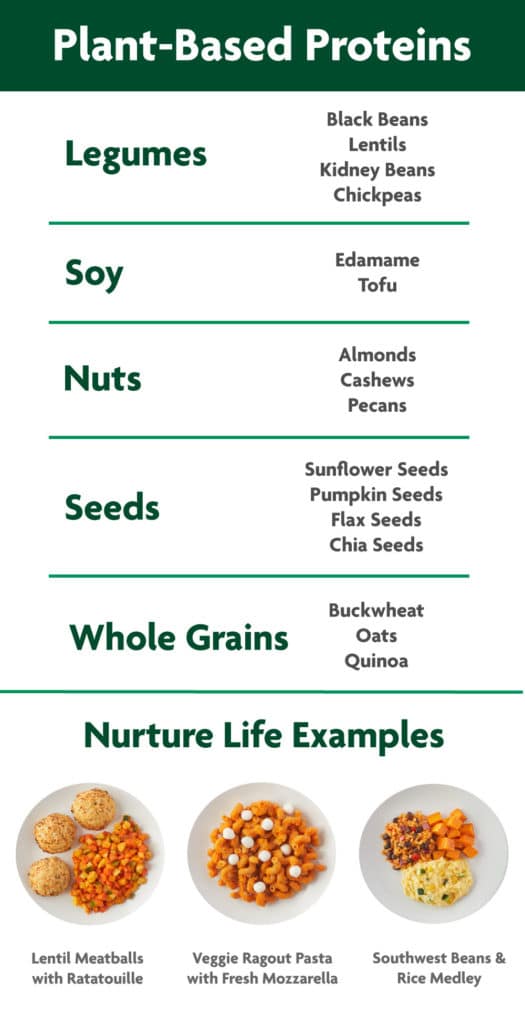
Is Plant-Based Protein Healthier for Kids?
Both plant- and animal-based proteins can offer different nutritional benefits as part of a balanced diet for kids:
- Amino acids: Animal-based proteins provide a complete source of essential amino acids, as well as important vitamins such as B12 and niacin, and minerals, including iron and zinc.
- Low in fat: Plant-based proteins are usually low in fat, free from cholesterol and high in key nutrients like folate, potassium, iron and magnesium.
- Fiber-rich: Plant-based proteins typically contain soluble and insoluble fiber, which helps keep our digestion regular and contributes to fullness after eating.
Nurture Life offers a variety of proteins for kids, so it’s easy to match our healthy kids’ meals to your child’s dietary preferences. Our vegetarian meals include Mac & Cheese with Hidden Butternut Squash with 17 grams of protein per serving and Cheesy Ravioli with Green Beans that has 9 grams of protein per serving.
All of our meat-based meals, like our Chicken Meatballs with Spiral Pasta & Veggies in the Kid size, come with hearty servings of vegetables and to provide essential vitamins, minerals and fiber.
Explore Protein-Rich Meal Options With Nurture Life
Protein is essential to growing strong and staying healthy at every age. By eating a variety of protein-rich foods like beans, nuts, eggs and meat, your kids’ bodies get what they need to thrive.
Keep a diverse stock of proteins on hand. Order a few of Nurture Life’s healthy kids’ meals to store in the fridge or freeze and save for later. You can easily round out your family’s favorite proteins with well-balanced, freshly made meals developed by registered dietitians. If you have any questions about your child’s daily protein requirements or our healthy meals for kids and adults, please reach out anytime! Just send your message to support@nurturelife.com.
Order from our wide selection of kids’ meals today.

